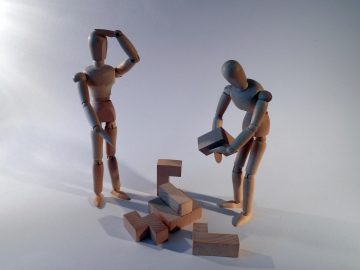Teachers can feel overwhelmed trying to support the different needs of their students. A group work activity can be a perfect strategy to encourage students to work together, develop their collaboration skills, build classroom community, and support each other.
What is group work?
Cohen & Lotan (2014) define group work as “students working together in a group small enough so that everyone can participate on a clearly assigned learning task” which should be carried out “without direct and immediate supervision of the teacher” (p. 1). These two characteristics are essential because they allow students not only to develop academic knowledge and competencies but also to learn social skills, such as collaboration and responsibility.
However, designing group work is not easy even in a homogeneous classroom and it becomes a big challenge in a heterogeneous classroom, where students have different cultural and language backgrounds, levels of knowledge, and many other distinct characteristics.
Thinking about the possible challenges of group work, Cohen & Lotan (2014) suggest that the group and the tasks should have some features that may help to minimize inequalities in educational settings.
The status problem
Cohen & Lotan (2014) highlight a serious problem in educational places: a student has a different status in the classroom based on both external or internal factors. For example, students who have a facility for mathematics tend to be granted a high status by their peers and teachers. As another example, students for whom English is their second language tend to have a lower status in school. The idea is that schools tend to value some knowledge and skills more than others and, therefore, students from some groups will not be considered “good students” because their competencies and knowledge are not considered “high status” in school settings.
With these considerations in mind, the authors suggest that group work can help change students’ status and, consequently, improve their learning. However, group work should follow some guidelines related to group composition and the nature of the task:
Tasks
To show that all students have equal importance during the group activity, tasks should be designed to include a variety of competencies and knowledge. Students should not be able to complete the task without the collaboration of all members. In this sense, Cohen & Lotan (2014, p. 85) suggest that a task should:
• be open-ended, productively uncertain, and require complex problem solving;
• provide opportunities for students to use multiple intellectual abilities to access the task and to demonstrate intellectual competence;
• address discipline-based, intellectually important content;
• require positive interdependence and individual accountability;
• include clear criteria for the evaluation of the group’s product and of the individual report.

Group composition
Cohen & Lotan (2014) argue that three points should be considered when a teacher plans the composition of a group:
1) Size of groups: groups should not be so small that they do not allow a complex interaction between members, but also not so big that they prevent all members from having meaningful participation.
2) Composing groups: the ideal composition is one that balances different skills, knowledge, and status. The authors recommend randomizing students to avoid any bias in group composition. However, teachers may want to think about specific intentions and try to diminish inequalities in their classroom.
3) Hold individuals and groups accountable: even though students are working in a group, it is important to think of both individual and group assessments. It may help to understand individual progression while also considering the value of group work.
Individual roles
Cohen & Lotan (2014) suggest that each individual in the group should have a different role; roles can help to balance power since all members will be essential to complete the task. In addition, teachers can rotate the roles between students, giving more voice to students who usually do not participate or prompting some students to develop specific skills.
The roles can change, but these are some ideas:
Facilitator: Ensures that everyone gets the help he or she needs to do the task. They can be responsible for seeking answers to questions within the group – the teacher is only queried if no one in the group can help.
Time Manager: Makes sure that the group is progressing and will conclude the task on time.
Materials Manager: Is responsible for getting materials and resources and putting them away properly.
Participation Manager: Is responsible for making sure that all members have space to express their ideas.
Reporter: Is responsible for organizing a group report and presenting to the class.
How to implement group work in the classroom?
- This post from the University of Waterloo discusses essential steps to consider when teachers design and implement group work in their classrooms.
- Group work can include drawings, playdough, games, or design challenges to get students thinking, discussing, and working together.
- Groups At Work: Strategies and Structures for Professional Learning, by Laura Lipton and Bruce Wellman is full of group work strategies and activities. Although these strategies are marketed for professional learning, most of them are perfect for classroom use! The strategies are broken into several categories that makes it easy to select an effective activity for your scenario:
- Strategies for Activating (consider using these for community & relationship building)
- Strategies for Assessing, Goal Setting & Planning (consider using these for self or peer assessment)
- Strategies for Dialogue & Discussion (consider using these to get students talking and verbally processing concepts)
- Strategies for Generating Ideas (consider using these for design thinking and ideation)
- Strategies for Summarizing & Synthesizing (consider using these to help students clarify their understandings and integrate concepts or information)
- Strategies for Text & Information Processing (consider using these when students are interacting with texts or new information)
Guest post by Peer Tutor Ariane Faria dos Santos (Ph.D. EDCP), 2021; Updated June, 2024 by Peer Mentor Lindsay Cunningham (Ph.D. student, EDCP)
References:
Cohen, E. G., & Lotan, R. A. (2014). Designing groupwork: strategies for the heterogeneous classroom third edition. Teachers College Press.
Lipton, L., & Wellman, B. (2011). Groups at work: Strategies and structures for professional learning. MiraVia.

